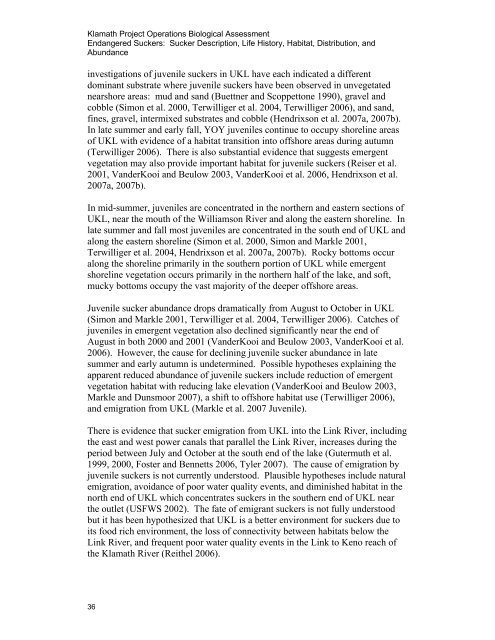Our new Biological Assessment is out - Klamath Basin Crisis
Our new Biological Assessment is out - Klamath Basin Crisis
Our new Biological Assessment is out - Klamath Basin Crisis
Create successful ePaper yourself
Turn your PDF publications into a flip-book with our unique Google optimized e-Paper software.
<strong>Klamath</strong> Project Operations <strong>Biological</strong> <strong>Assessment</strong><br />
Endangered Suckers: Sucker Description, Life H<strong>is</strong>tory, Habitat, D<strong>is</strong>tribution, and<br />
Abundance<br />
investigations of juvenile suckers in UKL have each indicated a different<br />
dominant substrate where juvenile suckers have been observed in unvegetated<br />
nearshore areas: mud and sand (Buettner and Scoppettone 1990), gravel and<br />
cobble (Simon et al. 2000, Terwilliger et al. 2004, Terwilliger 2006), and sand,<br />
fines, gravel, intermixed substrates and cobble (Hendrixson et al. 2007a, 2007b).<br />
In late summer and early fall, YOY juveniles continue to occupy shoreline areas<br />
of UKL with evidence of a habitat transition into offshore areas during autumn<br />
(Terwilliger 2006). There <strong>is</strong> also substantial evidence that suggests emergent<br />
vegetation may also provide important habitat for juvenile suckers (Re<strong>is</strong>er et al.<br />
2001, VanderKooi and Beulow 2003, VanderKooi et al. 2006, Hendrixson et al.<br />
2007a, 2007b).<br />
In mid-summer, juveniles are concentrated in the northern and eastern sections of<br />
UKL, near the m<strong>out</strong>h of the Williamson River and along the eastern shoreline. In<br />
late summer and fall most juveniles are concentrated in the s<strong>out</strong>h end of UKL and<br />
along the eastern shoreline (Simon et al. 2000, Simon and Markle 2001,<br />
Terwilliger et al. 2004, Hendrixson et al. 2007a, 2007b). Rocky bottoms occur<br />
along the shoreline primarily in the s<strong>out</strong>hern portion of UKL while emergent<br />
shoreline vegetation occurs primarily in the northern half of the lake, and soft,<br />
mucky bottoms occupy the vast majority of the deeper offshore areas.<br />
Juvenile sucker abundance drops dramatically from August to October in UKL<br />
(Simon and Markle 2001, Terwilliger et al. 2004, Terwilliger 2006). Catches of<br />
juveniles in emergent vegetation also declined significantly near the end of<br />
August in both 2000 and 2001 (VanderKooi and Beulow 2003, VanderKooi et al.<br />
2006). However, the cause for declining juvenile sucker abundance in late<br />
summer and early autumn <strong>is</strong> undetermined. Possible hypotheses explaining the<br />
apparent reduced abundance of juvenile suckers include reduction of emergent<br />
vegetation habitat with reducing lake elevation (VanderKooi and Beulow 2003,<br />
Markle and Dunsmoor 2007), a shift to offshore habitat use (Terwilliger 2006),<br />
and emigration from UKL (Markle et al. 2007 Juvenile).<br />
There <strong>is</strong> evidence that sucker emigration from UKL into the Link River, including<br />
the east and west power canals that parallel the Link River, increases during the<br />
period between July and October at the s<strong>out</strong>h end of the lake (Gutermuth et al.<br />
1999, 2000, Foster and Bennetts 2006, Tyler 2007). The cause of emigration by<br />
juvenile suckers <strong>is</strong> not currently understood. Plausible hypotheses include natural<br />
emigration, avoidance of poor water quality events, and dimin<strong>is</strong>hed habitat in the<br />
north end of UKL which concentrates suckers in the s<strong>out</strong>hern end of UKL near<br />
the <strong>out</strong>let (USFWS 2002). The fate of emigrant suckers <strong>is</strong> not fully understood<br />
but it has been hypothesized that UKL <strong>is</strong> a better environment for suckers due to<br />
its food rich environment, the loss of connectivity between habitats below the<br />
Link River, and frequent poor water quality events in the Link to Keno reach of<br />
the <strong>Klamath</strong> River (Reithel 2006).<br />
36










